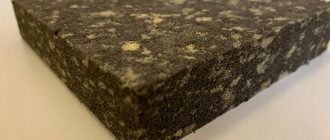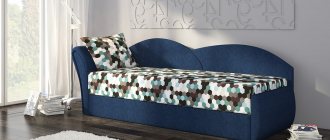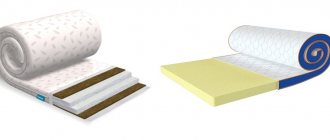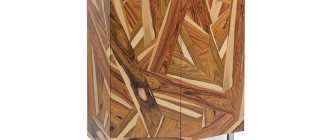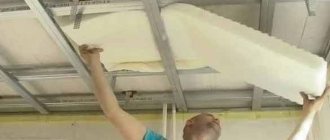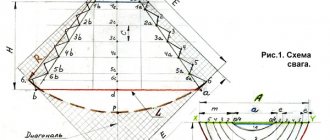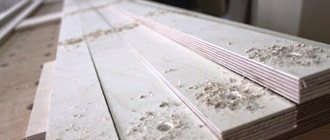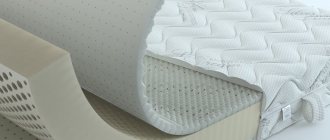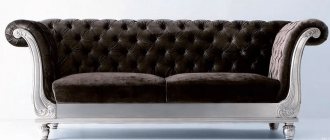PPU filler for sofas - what is it, its pros and cons
There is a huge range of furniture on the modern market. The buyer faces a difficult decision: what to choose? When choosing a sofa, most people focus on the appearance and often forget to ask about the padding. And it’s completely in vain, since the service life of the product as a whole and its comfort depend on it. In the article you will learn about the pros and cons of polyurethane foam fillers and what you should pay attention to when buying upholstered furniture.
What is PPU filler in a sofa?
The PU foam filler for sofas is polyurethane foam or furniture foam rubber. It has a porous structure and consists of 90% air. It has highly elastic properties, giving softness and elasticity to the product. Thanks to these characteristics, it is actively used as padding for furniture, car seats, orthopedic mattresses, toys, dish sponges, etc.
The sofa can consist entirely of polyurethane foam and be springless, or it can be a combination one, in which several fillers are combined at once (example in the photo below).
There are two main types of polyurethane foam:
- Block - consists of large sheets of polyurethane foam, from which the manufacturer cuts out the necessary parts. The product is made from blocks of different widths and densities. Such production is less expensive in price, but after it a large amount of trimmings remains.
- Cast - this type is poured in the form of a thick foamed liquid directly into a mold of the required size. The result is a finished part and no waste. But there is also a minus: with such production, a crust appears on top of the polyurethane foam, which does not allow air to penetrate inside.
Photo: Sofas with polyurethane foam filling
Furniture foam rubber (highly elastic polyurethane foam - HR)
The production of upholstered furniture, like other areas of production, is developing taking into account the scientific and technical process. New designs are created, production technologies are developed, new and more advanced resources are used.
HR furniture foam rubber is increasingly used in the production of upholstered furniture: high-quality mattresses, pillows, and ergonomic upholstered furniture are made from it. The unique properties characterizing HR furniture foam rubber allow you to completely replace standard furniture foam rubber.
Brief advantages of HR furniture foam rubber compared to currently existing standard brands of furniture foam rubber:
- The structure of the cells of this brand of furniture foam rubber HR is rough, heterogeneous, the cells have different sizes and are scattered in an indefinite order, accordingly they react differently to the load, which ensures its elasticity and comfort. If we consider the cell structure of standard furniture foam rubber , then its cells are homogeneous, that is, they have the same size and wall thickness. This leads, when loading furniture foam rubber, to the same deformation and the same work in terms of compression resistance.
- If the acting load on the surface is small, then only small cells with small wall thickness work. This corresponds to the effect of super-soft foam, but as the load on the surface increases, larger cells with greater compression resistance begin to work. This results in a wonderful feeling of comfort. On standard furniture foam rubber, this feeling can only be achieved by gluing several brands of furniture foam rubber with different parameters.
- Durability is probably one of the most important properties of this brand. For example, standard brands of furniture foam rubber have a relatively short service life in furniture products (from 2 to 8 years), after this period they abruptly begin to lose their initial parameters or begin to collapse. Furniture foam rubber HR , according to statistical and characterizing scientific data, has a service life of fifteen years or more, and after that it practically does not lose its performance properties.
Conclusions: although furniture foam rubber of the HR brand is slightly more expensive than the standard one, its excellent technical and operational properties fully compensate for the difference in price. And if you need to have high-quality and durable upholstered furniture, then our products and our offers will definitely interest you.
Polyurethane foam filler for sofas: pros and cons
Advantages of PPU
- safe for people with allergies;
- easy to maintain - does not accumulate dust inside itself and has good air permeability;
- has a long service life and high wear resistance;
- thanks to its elasticity, it easily takes the curves of the body and quickly restores its original shape;
- a large selection of hardness levels, so that everyone can choose comfortable furniture just for themselves;
- it is possible to produce products of any shape, even the most complex configuration;
- one of the most economical materials.
Flaws
- unscrupulous manufacturers often use furniture foam rubber of poor quality, which reduces its service life and increases the likelihood that the furniture will quickly sit out and change its original shape;
- does not tolerate direct sunlight and may begin to deform. During production, it is desirable to use light-protective materials as upholstery;
- polyurethane foam is a flammable material.
Which filling is better for a sofa: PPU or spring block
A spring block is considered a softer padding, and for those who like hard sofas, it is better to choose polyurethane foam. Both fillers have advantages and disadvantages, and you need to focus on your feelings. Before buying, you should definitely test the furniture for convenience and comfort: sit and lie on it.
If the choice fell on a spring block, then it is better to choose a block with springs independent from each other; it is more comfortable, elastic and wear-resistant. If you choose polyurethane foam, you should pay attention to the thickness of the material and its density; the thickness should be at least 4 cm, and the density should be from 30 kg/m3. There are also products where polyurethane foam and a spring block are adjacent to each other.
PPU is a modern filler, in no way inferior to spring filler. It is advisable to choose a sofa that is not in the budget category. It should be noted that when using any packing, manufacturers may use low-quality raw materials and outdated technologies. The cheaper the furniture, the worse the quality of the materials used. Sometimes such savings can quickly affect the loss of the original appearance of upholstered furniture, as well as your health.
Source: poztelio.com
What to choose: spring block or polyurethane foam?
One of the main questions that comes up when choosing a sofa is: which sofa to choose - with a spring block or with polyurethane foam? First, let’s briefly look at what types of spring blocks there are, how they differ, how their orthopedic properties manifest themselves, which are softer, which are more comfortable, and which are more reliable.
The very first spring block, which has been used in sofas for centuries, is a spring block with the beautiful name “bonel”. A spring block of this type is called dependent, because the springs at the top and bottom are connected to adjacent springs using horizontal parallel spirals (these spirals are long, thin springs). The entire perimeter structure is attached to a fairly thick edging metal wire or to a flat metal frame. The whole thing is made from high carbon spring steel, often stainless steel. As a result, when any one spring is loaded, adjacent springs are immediately activated, thereby distributing the load and preventing the springs from bending to the end. This spring block is very reliable and almost eternal. The softness of a sofa based on this spring block depends directly on the diameter of the wire used to produce the springs. But this is not the most important thing about the sofa. The most important thing in a sofa is what covers this spring block. The comfort and durability of the sofa depends on the quality of materials used in the manufacture of a “sandwich” based on a spring block. Most often, the springs are covered with a hard felt mat; this mat prevents the springs from protruding from the sofa, and a person does not feel them. But the mat is quite hard, and sitting on it would be uncomfortable, so then most often polyurethane foam (polyurethane foam - furniture foam rubber) is used, which gives the final softness. Sometimes this “sandwich” uses a layer based on coconut coir; when selling a sofa, they write: sofa with “coconut” - this does not improve the positive properties, it only increases the rigidity - but everyone likes it as an advertising ploy. Well, all this is covered with furniture fabric, which takes on the external load, and must be wear-resistant and not dirty. Conclusion: the quality of a sofa based on a spring block is determined not by the block (it is made of steel and is practically not subject to wear), but by the materials in which it is enclosed: fabric, polyurethane foam and felt mat.
Independent spring block: this is a block based on springs not rigidly connected to each other. In it, each spring is enclosed in a fabric bag, which is connected to others at several points. In this spring block, only the spring that bears the load is pressed, while neighboring springs are minimally involved. When making a sofa, a spring block based on independent springs is also covered with a layer of covering materials. The softness of this spring block also depends on the thickness of the spring wire. The quality of a block based on independent springs is determined by the number of springs per square meter - the more, the better. An “independent” spring block may be a little more comfortable than a “dependent” one, but it is less reliable, and the quality of its manufacture greatly affects its reliability. Therefore, when choosing a sofa with an “independent” spring block, it is advisable to know who its manufacturer is: if it’s a large, reliable company, that’s good, but if you don’t know who, that’s bad, and in this case it’s better to choose a regular “dependent” one - it won’t let you down.
PPU – polyurethane foam – popularly known as foam rubber. This is a modern elastic material. During its production, it can be given the necessary properties. And this is widely used in the manufacture of upholstered furniture. Polyurethane foam can be made harder or softer, elastic or not very elastic; you can use additives to increase its service life many times over. At the same time, the convenience of such a polyurethane foam will be even higher than that of an independent spring unit, and its service life will be much longer. Also, polyurethane foam allows you to make sofas of a shape in which the use of a spring block is impossible or undesirable. But PPU PPU is different, and if cheap “foam rubber” is used in the sofa, then this sofa will quickly “sag” and become uncomfortable. But if the sofa is made in a good factory, then it is almost guaranteed that the polyurethane foam there is real, furniture-grade. It easily withstands any load, quickly restores its shape, and is very durable.
What to choose: spring block or polyurethane foam? It's up to you to decide. Both materials are of equal quality if they are made well. Therefore, it is better to choose a manufacturer with a good reputation, then both the spring block and the polyurethane foam will be a good choice, will last a long time and will be pleasant to use. It is also advisable to sit on the sofa before buying - by doing this you will determine for yourself whether it is suitable for you. Some people like it harder, some like it softer. Some people like the sofa to “sink” when you sit on it, while others want it to keep its shape. All tastes are different, and the choice of polyurethane foam or a spring block is not important, since these are just tools with which manufacturers achieve the desired effect in the production of upholstered furniture. The main thing is a reliable, time-tested manufacturer.
Which filling to choose for a sofa?
How often do you choose upholstered furniture based on its appearance, without thinking about what’s inside? But the internal content is no less important. The reliability and durability of the seat, back and armrests, as well as the comfort and ease of seating directly depend on the filling for the sofas. Therefore, you need to approach its choice no less carefully than choosing the color of the upholstery or the shape of the sofa.
What is better - springs or highly elastic polyurethane foam (PPU)? We talk about the most popular materials and help you decide which filling is best for your sofa in order to get a comfortable and durable place to relax for many years.
Fillers for sofas
Spring:
- Dependent spring block,
- independent springs.
Springless:
- polyurethane foam,
- natural latex,
- synthetic down,
- periotec, quilted jacket,
- combined filler.
06.04.2014
Spring block VS PPU. Before buying upholstered furniture, as a rule, the question very often arises: which filling of the sofa is better - a spring block or PPU (polyurethane foam)?
Spring block VS PPU
Before buying upholstered furniture, as a rule, the question very often arises: which filling of the sofa is better - a spring block or PPU (polyurethane foam)? Here you need, firstly, to answer yourself, on which surface is it more convenient for you to lie or sit - on a hard one or on a soft one? For lovers of a hard sleeping place, we suggest considering the option of filling upholstered furniture with polyurethane foam. Polyurethane foam is a foamed synthetic material. It replaced the short-lived foam rubber. PU foam perfectly retains its shape and has good elasticity, providing the sleeping person with optimal comfort, as it anatomically adapts to the contours of the body. This material can withstand decent weight, easily restores its shape, is environmentally friendly and hypoallergenic, does not absorb or emit dust. It lasts quite a long time if used properly. In addition, polyurethane foam is much cheaper than a good spring block (what a good spring block is will be discussed below). But it should be noted that polyurethane foam comes in different qualities. Choose highly elastic polyurethane foam, it is durable and will not turn into pits and bumps a month after purchase. For those who find it more comfortable to sleep on a soft surface, sofas equipped with spring blocks are offered. Bonnell spring blocks are blocks of interlocking springs, which is their main disadvantage. Springs interlocked with each other do not allow the sleeping place to adapt to the curves of the human body, which means they do not provide complete rest. With independent spring blocks, the situation is much better - each spring is in a separate “cup” and works independently of the springs next to it. The sleeping place, equipped with an independent spring block, is soft, adapts to the anatomical curves of the body, allows each muscle to relax and gives complete rest. In our opinion, both the polyurethane foam and the spring block deserve attention and the only thing left to do is to decide on your priority - whether you prefer a hard or soft sleeping place. The “Divan-ON” store invites you to familiarize yourself with the range of upholstered furniture on our website and choose something that is sure to serve you for a long time and give you comfortable sleep and relaxation.
What is it: classification of fillers
There are two large groups of upholstered furniture fillers: with springs and without springs.
In the first case, several layers of natural or artificial covering material - coconut coir, latex, foam rubber, felt, etc. - are laid on cylindrical springs or a base made of a spring “snake”. The different densities of a particular coating and many spring options make it possible to create fillings of different degrees of rigidity.
Springless fillers are based on highly elastic polyurethane foam (PPU, furniture foam rubber) - an inexpensive, but durable and elastic artificial material.
Springs
The spring block comes in two types: with dependent (Bonnell type) and independent springs. Both options are very durable, provided that there is a sufficient number of intermediate layers between the block itself and the outer upholstery.
Dependent spring block
A classic, time-tested option. Here all the springs are connected to each other by a continuous spiral steel wire. If you press one spring, the others will immediately connect to it, thereby distributing the load across the entire base. The structure is attached around the perimeter to the edging frame and covered with an intermediate layer of non-woven material.
Independent spring block
In a block of this type, each spring lives its own life” and does not depend on its neighbors, which gives the surface high point elasticity and allows it to better adapt to the contours of the body.
Spring snake
Attached to a wooden or metal base using a hinged bar or steel brackets, the “snake” is a simple and inexpensive spring base. And although it is not a full-fledged filler - a layer of polyurethane foam is always laid on top - it can withstand heavy loads, does not deform and is very durable.
Polyurethane foam (PPU or furniture foam rubber) is an inexpensive and highly elastic furniture filler. Provides a comfortable fit, has good elasticity and is environmentally friendly.
For the base of a sofa with such filling, as a rule, block furniture foam rubber is used, cut and twisted in a certain way. Some models require special molded polyurethane foam blanks, which are also used as a filler for pillows - the material allows you to hold any shape given to it.
The PU foam filling in the sofa comes in different brands - standard, luxury PU foam, memory foam foam, etc. The higher the properties of the material, the more expensive the sofa will cost to manufacture.
Types of furniture filler, their pros and cons
Choosing furniture for sleeping and relaxing requires a thorough approach. Usually it depends on the purpose of the product (a folding guest version or a sofa bed that replaces a full bed).
The filler comes in different types, degrees of softness, and is made from natural, artificial fibers and mixtures thereof. When choosing a sofa for the arrival of guests, you can purchase a product with soft filling. If you plan to operate at full capacity, then you cannot do without rigid filling, which, in addition to evenly distributing the load, has an orthopedic effect.
Artificial
Synthetic fillers are made from different fibers and come in spring and springless types.
Springless
In most springless models, manufacturers use fillers made from inexpensive raw materials that are not burdensome to work with. The most striking representative of the series is polyurethane foam (abbreviated as PPU). To understand what it is and why it is better than a spring block, you need to know the characteristics of the filler.
In essence, polyurethane foam is elastic furniture foam rubber of various qualities, which is made from a mix of synthetic polymers and looks like a sponge in sheet format. PPU is divided into two types:
- standard (regular type T);
- foam rubber type HR (integral polyurethane foam).
Block polyurethane has different densities. It is a sheet filler of medium and hardness, which is cut to the specified dimensions and connected to obtain the required thickness. It is glued together in the form of a sandwich, connecting sheets from hard to soft. In order not to get confused by the thickness of the sheet, they are painted in different colors.
This is an inexpensive, but not particularly practical material.
Cast polyurethane foam is produced by casting, pouring into a specific mold, which is a part of the model (for example, a backrest, seat or pillow). When hardened, the composition takes on the desired configuration, so this method eliminates additional trimming of parts. The result is a finished element, which is complemented by upholstery.
This material costs more than its block counterpart.
Cast filler is considered elastic - it cannot be rolled, although it is quite resistant to bending. This material can withstand daily loads and does not delaminate, but after several years of use it may slightly change color. Its advantages include excellent breathability, resistance to tearing, and restoration of shape after compression.
Spring block
The filler in the form of steel springs in the case is considered the most durable and practical.
It is divided into three varieties:
- Bonnell. Dependent type, which involves connecting springs using a spiral wire made of steel;
- Snake . Original coil springs located horizontally at equal distances from each other;
- Independent type. Each spring is covered in a fabric cover and operates independently of the others; the unit is assembled by connecting the covers.
The first two types of springs stretch in the horizontal direction. The independent type block is designed in such a way that each spring is directed perpendicular to the floor. The spring block is attached to the frame and ideally has sheathing on both sides.
In some cases, it is supplemented with polyurethane foam, felt and thick textiles.
The advantages of a spring block include durability, resistance to maximum loads, and free air exchange. It also provides comfort during sleep, a smooth surface and elasticity of the sleeping bed.
The disadvantages of the filler are a small choice of shapes, the possibility of squeaking during operation, high cost and expensive repairs (in case of replacing the block).
You can learn more about the features and nuances of the spring block from the following video:
The fillings of the backs and armrests are synthetic down and padding polyester, as well as periotek (a modification of felt of natural or synthetic origin).
Natural
Natural fillings for a sofa include latex, coir (coconut fiber), and sisal (plant fiber from Mexican agave). The rarest addition to the filler is horsehair. It is a component for a mat with coconut filling.
Natural fillers come in different thicknesses and are often used for furniture with an orthopedic effect.
They eliminate the “immersion” effect and therefore do not sag.
Coir is considered one of the most practical and useful materials. This is a natural, hypoallergenic filler that maintains normal air exchange and also prevents the formation of fungus and mold. It is ideal for the skin and is a good prevention of musculoskeletal system problems.
Among the fillers of natural origin, quilted cotton is used . It is a canvas from 5 to 10 cm in thickness, which is covered with dense textiles on both sides.
This filler is used in conjunction with a spring block and makes the elastic mattress softer.
Combined
Today on the furniture market you can find interesting solutions with a combination of fillers. Externally, such a mat is a layer of two or three layers of materials of different compositions. One filler of different densities or different materials can be used.
For example, a polyurethane foam filler can be supplemented with padded padding, a spring block with foam rubber or coir, and so on.
In addition, the model can be made with parts of varying degrees of softness: the seat is usually hard, the back and armrests can be made of medium-hard filler, and the pillows can be made of very soft material.
Other materials
Furniture fillings are not limited only to foam rubber and springs - other materials are also used as additional layers for filling.
Natural latex
A base made of natural latex is often used in expensive upholstered furniture - the material is highly elastic, instantly restores its original shape, is non-toxic, hypoallergenic and has a long service life.
Sintepon
The most inexpensive, but very durable artificial filler. It creates additional softness and elasticity. Also, the material is not susceptible to fungus formation. The main disadvantage is that with regular use it does not hold its shape; characteristic dents and irregularities appear on the surface. In case of constant use, this material should be considered in combination with polyurethane foam as a covering layer - its share in the filling is small, but one way or another it can improve the shock-absorbing properties of the seat.
Holcon (struplast)
A modern non-woven material consisting of an intermediate layer of vertically laid synthetic polyester fiber and two covering layers of dense reinforcing ribbed surfaces. This method of laying allows the mattress or pillow to sag only in places of pressure and quickly restore its shape.
Holcon is easy to care for, retains heat well, has increased elasticity, is environmentally friendly and does not absorb moisture and odors.
There is no definite answer to the question of what is the best filling for a sofa, but you can protect yourself from inconvenience and disappointment by choosing the “filling” according to the purpose of the future sofa. So, for a sleeping place it is better to consider a filler with a more rigid and flexible base (highly elastic polyurethane foam, independent spring block, natural latex), because Regular rest on an overly soft or creased bed can have a bad effect on the spine. But the guest option provides for any content.
Source: m.divan.ru
Filling upholstered furniture.
The content of upholstered furniture is the most important factor to consider when choosing it.
Traditionally, when choosing upholstered furniture, the buyer pays main attention to the design of the model and its colors, while its internal contents, or rather the filling, in most cases turn out to be outside his area of interest. It is this kind of neglect that most often becomes the reason for the possible appearance in a couple of years of “bedsores” on sofas or overused seats on chairs.
The most “ancient” and the only filling before the advent of polymer materials are spring blocks, which form the basis of any sofa or chair. Springs of continuous weaving from high-quality, specially hardened steel wire are assembled into a special block, which represents the skeleton of the future seat or backrest. This is followed by several layers of covering materials that perfectly allow air and moisture to pass through. Depending on the cost of future furniture, they can be either natural (felt, horsehair or coconut coir) or synthetic (polyurethane).
Upholstered furniture based on high-quality spring blocks is strong and durable. Its main disadvantage is considered to be its relatively high cost, but it is more than compensated by its high service life, because spring upholstered furniture lasts for decades.
The basis of other spring furniture is made up of blocks of independent springs. A block of independent springs consists of fabric pockets fastened to each other, inside which cylindrical or barrel springs are placed. The springs do not have a rigid attachment to each other, and work independently of each other, so mattresses made from independent springs instantly take the shape of the body, helping to evenly distribute loads on it and quickly restore strength.
Like spring ones, blocks with independent springs “breathe” perfectly and allow moisture to pass through, providing comfortable sleeping conditions. The special ergonomic and pronounced orthopedic properties of furniture with independent spring blocks make it the most attractive to the buyer.
The emergence of synthetic materials has opened up new prospects for furniture manufacturers, and today polyurethane foam fillers (PPU) constitute an excellent alternative to spring fillers for upholstered furniture. A high-tech and relatively inexpensive material, it allows you to significantly save on both raw materials for furniture production and labor costs. Polyurethane foam does not pose a danger to human and animal health, and also has a fairly high durability (service life 5 - 8 years).
Technologically, PU foam fillers can be produced in two ways.
In the first case, the filling elements (backrests, seats, etc.) are manufactured as composite elements. To do this, sheet polyurethane foam of various densities supplied to the furniture factory is cut and cut, and then glued into parts of the required shape.
In the second case, the full production cycle of cast fillers takes place directly at the furniture manufacturer. Polymer components are pumped into special molds, where they mix and, as a result of chemical reactions under pressure, foam and harden. As a result of waste-free production, ready-made furniture parts of any shape and size, even the most complex, are obtained.
The main disadvantages of furniture with PU foam filling include low air permeability, this is especially true for cast fillers, since during polymerization a dense airtight film is formed on the surface of the polyurethane foam product.
Today, upholstered furniture of all types of fillers is equally in demand. Opting for an expensive but durable spring or inexpensive polyurethane foam is the exclusive right of the buyer.
Which foam rubber to buy for a sofa: what to look for
Hi all! Some create furniture from scratch, while others simply need to replace elements of old furniture that are worn out and no longer suitable for further use.
A striking example here is foam rubber for a sofa. Even in high-quality furniture, it can wear out and sag over time. This violates the desired level of comfort, and therefore the foam needs to be replaced.
Self-assembly is even easier. To reupholster, you first need to lay something soft under the sheathing material. And here the best solution would be foam rubber.
And so that it does not get pressed, the pillows can serve for a long time and create a high level of comfort, you need to approach the issue of choice wisely. Therefore, today I suggest you find out how to choose a suitable product, how important parameters such as density, thickness and hardness play, and what are the key nuances of purchasing this product.
What it is
If you are thinking about how to replace worn-out foam rubber in furniture, then the best option is definitely to purchase the same foam rubber, or even higher quality. Before studying the types and trying to find out which is better, let’s understand the very essence of the material.
Foam rubber is a type of polyurethane foam, therefore the material can also legally and reasonably be called polyurethane foam. The strong opinion about foam rubber as a low-quality material is no longer relevant.
Currently it is used as:
- furniture upholstery element;
- popular packaging material;
- isolation;
- material to ensure heat conservation of various pipes;
- construction material;
- component for sports mats;
- filler for children's playrooms, rooms, etc.
Buying polyurethane foam of various types for appropriate purposes is not a problem at all today. And it doesn’t matter whether you live in Tyumen, cities like Chelyabinsk, Volgograd, Perm, Krasnoyarsk, Moscow or in some suburb. There are hardware stores everywhere. Plus, he does not forget about the possibility of purchasing inexpensively at retail in Leroy Merlin and through online stores.
Varieties
If we talk specifically about furniture foam rubber, then replacing it with material used in construction is not the best idea. Furniture production is constantly being improved, which allows us to improve technology and improve quality.
Several types of polyurethane foam are used simultaneously in sofas, since each section requires appropriate characteristics.
Foam rubber is divided into the following types:
- Standard. Marked with ST symbols. It is produced with different densities and can be used in various fields;
- Hard. You will recognize it by the HL marking. The best in terms of strength, but the scope of application is much narrower;
- Increased rigidity. Marked with EL. The structure is solid and can withstand heavy loads;
- Soft. It is labeled as HS. Creates comfortable landing surfaces, but easily bends under the influence of weight;
- Highly elastic. Its marking is HR. With relatively low rigidity it can withstand heavy loads. Easily and quickly restores shape;
- Viscoelastic. It can adapt to various forms of loads and weights, while distributing it over the entire available surface.
It’s difficult to say clearly which one is better. The price of products varies, which largely depends on parameters such as density, hardness and manufacturer’s brand. If we talk about how much a product costs, then prices can vary from several hundred to several thousand rubles, and sometimes more.
This is not really a complete classification. But in terms of filling the sofa, we are of little interest in non-flammable, secondary foam, reticulated and other subcategories of polyurethane foam.
Functions and Features
Various types of furniture foam are designed to perform specific functions and fill different compartments of the sofa. After all, when one sofa is made, it simultaneously includes several types of foam rubber with different characteristics.
- Standard. The most popular and widespread. It is used in furniture production and for self-assembly or restoration. It is actively used in the design of corner sofas and children's sleeping places. But the downside is that it can’t handle heavy loads. The densest option cannot withstand more than 90 kg of weight;
- Hard and polyurethane foam with increased rigidity. Well suited for sofas where people often sleep. These foams are used to fill mattresses. High density and no weight restrictions make this foam an excellent choice. But to increase comfort, it is recommended to lay another layer of polyurethane foam on top, but softer;
- Soft. Rarely used as the main filler in sofas. Designed for a softening function, therefore it acts as a layer after hard polyurethane foam. They are mainly used in the backs and cushions of sofas. It wears out quickly and does not last more than 5-6 years;
- Viscoelastic and highly elastic are quite exclusive, rarely found on sale and are expensive. They are used in the production of the most expensive and luxury furniture. The best types of foam rubber among all existing ones.
Advantages of polyurethane foam
Effective and durable - this is how polyurethane foam insulation can be characterized. Polyurethane foam is technologically advanced in the application process and trouble-free in operation, does not require surface preparation before spraying, and is easy to transport in the form of components.
Polyurethane foam is at the same time an insulation material, a waterproofing agent, and a parabarrier.
It has no equal among traditional materials in the speed of installation and the ability to fill the most inaccessible places. In addition, one insulating layer of polyurethane foam can simultaneously perform several functions : insulation, sound insulation, vapor barrier, sealant. Polyurethane foam products are lightweight. The lightness of this material allows it to be used in construction without fear of overloading load-bearing structures and foundations.
Its durability lies in the fact that over many years the structure does not lose its insulating qualities and strength properties. The finished coating is extremely resistant to mold and microorganisms. The foam has a wide range of thermal stability : it can be used in the temperature range from -60 to +100°C. In the presence of fire retardants in the composition, it is classified as a low-flammable and non-combustible material, which is not typical for plastics. PUF is odorless, does not emit hazardous or ozone-depleting substances, is neutral to the environment and harmless to humans.
Recommendations for selection
If you are faced with the task of choosing the optimal foam rubber for all characteristics that will be used in the sofa, listen to a few practical tips.
- Look at the density parameters. This is the first thing people pay attention to. In fact, a density of 30 to 40 units is ideal for organizing the sleeping area of a sofa. It will be comfortable, soft enough, but will not wear out quickly. For seats and sleeping areas, choosing a density less than 30 is not recommended. And for armrests and backrests, 20-30 units are enough. The density indicator appears in the marking immediately after the letters. That is, something like ST 3542. Here the density is 35;
- Rigidity. Having decided on the density, immediately look at the hardness. It follows the first parameter in the standardized labeling. If you look at the sample above, the hardness there is 42 units. In general, foam rubber can have a hardness in the range of 15-45 units. The higher the value, the harder the product will be;
- Strength. Displays the force required to cause the foam to tear or stretch. The higher the strength, the longer the polyurethane foam and the entire sofa will last;
- Parameters of residual deformation. This characteristic indicates the ability of foam rubber to return to its original shape and the time spent on recovery. If the coefficient is high, this is bad, since such characteristics indicate low quality of the product.
In fact, you need to be extremely careful when choosing the foam rubber with which you are going to fill the sofa.
The thickness of the product actually doesn’t say anything. Even thick sheets of foam rubber can wear out quickly, sag under a fairly small weight and not restore their shape after the influence of body weight stops. As a result, your sofa will not live up to your expectations at all. And the fault will simply be an incorrectly selected filler or softener. Now call it what you want.
I would like to note that it is not necessary to chase very thick polyurethane foam to lay it in one layer under the upholstery of the sofa. You can take a thinner product, but with good characteristics. The material is used in one layer for backrests and armrests, but when folded in several layers, the result is an excellent soft, quite elastic and deformation-resistant sleeping place. After all, thicker sheets are noticeably more expensive. This is already a small trick to save money without sacrificing quality.
You can clearly see that the choice of furniture foam rubber is associated with certain nuances, requires a competent approach and must take into account several basic characteristics.
But I am sure that you will be able to cope and make the right choice. Therefore, I can only wish you good luck with your purchase.
Thanks to everyone who reads us! Subscribe, leave comments, ask questions and don’t forget to tell your friends about us!
Source: vmk-mebel.ru
Spring block
The spring block is not modern, but is still popular
They are distinguished depending on several factors:
- thickness of the metal rod that is used for the spring
- number of springs per 1 sq. m
- spring diameter
- spring height
These data together determine the anatomy of the sofa, i.e. its ability to adapt to the position and structure of the body. Springs made of thinner rods and small diameters better support the body and follow its contours. The total number of such springs per 1 sq. m. affects the ability of the product to withstand heavy weight and the period of operation.
- long period of operation
- ability to withstand heavy body weight
- reliability
- orthopedic properties beneficial for the spine
- smooth surface, with sufficient elasticity and rigidity
- good air and moisture exchange
- Over time a squeak appears
- expensive repairs
There are 2 types of spring blocks
The rigid connection between the springs affects comfort
Springs are made from high quality steel. To connect them, high-carbon steel wire with knots is used. Everything is secured with lower and upper metal frames. The total number of springs depends on the manufacturer. In this design it is 100-150 pcs/sq. m.
The bonnel block is very reliable and resilient. It is capable of holding heavy loads. People weighing more than 100 kg can safely use such a unit. Metal frames make the structure even more stable, because eliminate swaying and sideways movement of elements. This increases the service life of the unit.
The top of the springs is covered with additional filler, such as felt, padding polyester, or other materials. This softens the feel of the springs, making the product more comfortable.
A good option for a sofa in the living room.
Each of the springs is an independent element
Non-woven fabrics have the maximum level of strength and are environmentally friendly. The material is not subject to rotting, which prevents the development of bacteria and fungi. Has good resistance to all types of friction.
The covers are attached to each other using flexible connections, which enable each spring individually to demonstrate its elastic qualities. The structure itself is additionally glued with non-woven fabric on both sides. Due to this, its shape is strengthened. Block deformation is eliminated. It is protected from mechanical impact. Springs are used from thin wire and small diameter, and their number in this design reaches 350 pcs/sq. m and above. These characteristics indicate a high level of comfort of the filler. It is not subject to sagging or vibration when changing body position, and is silent in use.
This design distributes the load pointwise and follows the contours of the body, ensuring the correct position of the spine regardless of how the person is positioned.
The price of such a block, compared to a Bonnell block, is significantly higher. This is explained by the fact that manufacturing the structure requires more time, labor, and costs.
A good sofa option for good sleep and relaxation. Such a filler will not solve back problems, but will help cope with fatigue and tension in the muscles, and relieve the load on the spine.
Technical characteristics of polyurethane foam
- frozen density: from 26 to 300 kg/m3;
- number of closed pores: minimum 90%;
- thermal conductivity: from 0.022 - 0.03 W/m K;
- breaking stress (compression): 0.15-1.0 MPa, (bending): 0.35-1.9 MPa;
- water absorption: 1.0 - 5.0%;
- flammability: low-flammability (GOST 12.1.044);
- service life: minimum 30 years;
- operating temperature range: from -160°C to +150°C.
As an insulation material, in comparison with materials of similar use, polyurethane foam stands out in that it combines most of the positive aspects of its competitors, being a leader in application. At the same time, it is free from most of the disadvantages inherent in other materials. Photo and video materials demonstrating a wide variety of application methods and an impressive range of design solutions allow us to recognize polyurethane foam as a universal material with wide application, the reviews of which are extremely positive.
Spring snake
Simple and inexpensive spring base
The snake spring block is also a type of filler. Very often used in the furniture industry, including sofas. Used in soft elements, mainly in the seat and backrest.
The springs are made of galvanized metal and are attached transversely to the wooden base of the sofa with hinged strips or clips. Their number depends on the size and purpose of the product. The base of the structure is made up of these springs. The top is then covered with a layer of felt, batting or foam rubber.
The spring snake allows air to pass through well, so any moisture will evaporate and the product will dry quickly.
The seat has a springy effect and is quite soft. Not resistant to heavy loads. After a short time it begins to sag. This is a big disadvantage for sofas with such filling, which are not recommended for frequent use and are not suitable for sleeping.
The difference between ND and HP equipment is in the method of mixing raw materials
Equipment for spraying low-pressure polyurethane foam is a device in which the components are mixed in a mixing chamber at a pressure of 6-10 atm. The mixing device is either compressed air from a compressor (for spraying technology) or a mixer (for pouring technology).
The figure shows three ND models that we offered in December 2020: PENA-15, PENA-20 and PENA-25. At that time, PENA-20 and PENA-25 were already equipped with standard devices for rapid heating of polyol and isocyanate.
In June 2020, to these three installations we added a fourth, PENA-10. This is a budget option, which, for obvious reasons, we see no point in comparing with HP installations.
High-pressure spraying equipment is a device in which the components are mixed in a mixing chamber at a pressure of over 140 atm. Here the components are mixed due to mutual penetration into each other.
And we manufactured such a unit in October 2020. It successfully passed field tests and in August 2020, the NST company began mass production of machines, as in the video.
| Application of polyurethane foam using the best domestic installation PENA-VD-01 |
Polyurethane foam
For those who love comfort no less than savings
Polyurethane foam sofa filler (PPU) is a synthetic porous substance or furniture foam rubber. Consists of cells that are filled with air. The volume of the material is 90% air. It is used in furniture production as a flooring material or, due to its compactness, as the main filler for sofas.
PPU is produced in 2 types:
The molded type is denser and costs more.
The material also differs in density. The required density indicators for furniture are 30-40 kg/sq.m.
- high-quality material can last a very long time
- environmental Safety
- recovers in shape after exposure to stress
- It allows air to pass through well, which prevents possible moisture from accumulating in it.
- has thermal insulation, antibacterial, antifungal, antiallergenic properties
- cheap types become unusable over time and begin to crumble, and heavy loads can leave dents in them
- deforms in direct sunlight. To avoid this, the filler is covered with a special upholstery that protects it from the sun.
- Many consumers do not like the higher density of polyurethane foam, because products with such a surface are very hard
This sofa will be a wonderful sleeping place. The polyurethane foam filler is not inferior in properties and comfort to an independent spring block, but it is more affordable in price.
Technical characteristics of polyurethane foam
Table of polyurethane foam indicators.
If you get acquainted with the characteristics, it would be better to do this using the example of solid polyurethane foam, since this is the type that is most often used in construction. Its advantages include the following properties:
- able to retain heat;
- does not allow steam and moisture to pass through;
- does not corrode;
- does not absorb radiation;
- has the ability to withstand aggressive chemical environments;
- high adhesion;
- does not require fastening elements;
- does not have cold bridges;
- environmental cleanliness.
In addition to all its advantages, it is durable and can withstand large temperature changes.
When performing work, polyurethane foam can be sprayed onto any material to be finished, be it wood, glass, metal, concrete, brick, paint and even any uneven surface. After applying the material, no special insulation fasteners are required. Polyurethane foam can be used for soil and roofing work, but it must be protected from direct ultraviolet rays.
Return to contents
Natural latex
Ideal for all sleep products
Natural latex is made from rubber of natural origin. Rubber in its pure form is very capricious, so it is supplemented with an inhibitor.
The material is widely used in filling furniture. The proportion of rubber in such a filler should be in the range of 45-65% in order for it to have the necessary qualities:
- elasticity
- elasticity
- wear resistance
Natural latex is one of the best fillers. It has unique properties.
- Thanks to the high level of elasticity, it supports the body well, eliminating unnecessary swaying and swaying. Restores shape very quickly
- The latex structure gradually adapts to the contours of the body and responds even to light pressure. This makes it very comfortable, allowing you to support those parts of the body that need it: neck, head, lower and upper back, spine
- The porous structure allows air to pass through well, which prevents moisture from accumulating in the filler itself.
- Has good thermoregulation: keeps warm in winter, keeps cool in summer
- The high quality and strength of latex makes the filler durable in use and less susceptible to deformation.
- The material is hygienic and hypoallergenic
- The filler is absolutely silent in use
- The disadvantage is the high cost of this filler.
There is artificial latex - highly elastic polyurethane foam. The main differences between natural filler: it has a grayish tint and feels greasy to the touch.
Sintepon
Creates additional softness and elasticity
It is an intermediate material. The top of the filler is covered with padding polyester. It is also used to fill sofa cushions.
Available in various densities. Required density indicators for different furniture elements:
- back, armrests – 300 g/sq.m
- seat – not less than 400 g/sq.m
- pillows – more than 300 g/sq.m
These indicators must be strictly observed. Then the sofa will be soft and visually attractive. It will delight you with its coziness and comfort.
This material is popular for its properties.
Source: krrot.net
Choosing a topper for a specific purpose
- Coconut – used to stiffen a flat bed. It will help to smooth out the texture of a sofa with soft latex pillows, but it is not the best option for leveling a hard sofa.
- Periotec is considered a semi-rigid filler. If you need to level a sofa consisting of pillows, and not change the character of a semi-rigid sleeping place too much, it will do the job perfectly.
- Natural latex - such softness and elasticity makes even a thin mattress an almost complete sleeping surface. Latex will both level and make any sofa more comfortable. Its feature is to retain heat. Those who like hard and cool mattresses may not be suitable; they need to choose a topper with coconut or holofiber.
- PPU foam - in this category, the most famous are thin mattresses made of high-quality foam rubber - artificial latex, molded in the form of wavy cells. Manufacturers advertise their massage effect, but you need to take into account the good orthopedic support and softness of such toppers. They are created primarily to improve sleep comfort. A thin mattress made of standard foam rubber is stiffer, it is able to smooth out the bumps and depressions of the bed. And a mattress made of so-called shape memory foam has very special properties. It will not help to even out the relief in any way, but it will give you a special feeling of comfort and bliss.
PPU sofa filler: types, properties, quality indicators
To choose a really good sofa, in addition to the reliability of the frame and the strength of the upholstery, you should pay attention to its interior. Since not only the durability of the product, but also the comfort of use depends on it.
At the base of each sofa there is a spring block or polyurethane foam. Very often buyers ask: which is better? It will be easier to make the right choice if you know the main characteristics of these fillings. Our blog has an overview of the types of spring blocks for mattresses. The same Bonnel or TFK is used in upholstered furniture. Basic information can be read there.
And in this article we will talk about the PU foam filling for the sofa: what kind of material it is, what types there are and what their properties are.
